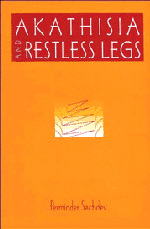Book contents
- Frontmatter
- Contents
- Foreword
- Acknowledgements
- Abbreviations
- Part I Introduction
- Part II Drug-induced akathisia
- 4 The definition of drug-induced akathisia
- 5 Epidemiology
- 6 Clinical characteristics and diagnosis of acute akathisia
- 7 Clinical characteristics of tardive and chronic akathisia
- 8 Akathisia due to a general medical condition
- 9 Assessment and measurement of akathisia
- 10 Aetiology and pathogenesis of akathisia
- 11 Treatment of drug-induced akathisia
- Part III Restless legs syndrome
- Part IV Conclusions
- Appendix A Haskovec's Akathisie
- Appendix B Prince Henry Hospital Akathisia Scale
- Appendix C Barnes (1989) Akathisia Rating Scale
- Appendix D Hillside Akathisia Scale (version 4)
- References
- Index
9 - Assessment and measurement of akathisia
from Part II - Drug-induced akathisia
Published online by Cambridge University Press: 12 September 2009
- Frontmatter
- Contents
- Foreword
- Acknowledgements
- Abbreviations
- Part I Introduction
- Part II Drug-induced akathisia
- 4 The definition of drug-induced akathisia
- 5 Epidemiology
- 6 Clinical characteristics and diagnosis of acute akathisia
- 7 Clinical characteristics of tardive and chronic akathisia
- 8 Akathisia due to a general medical condition
- 9 Assessment and measurement of akathisia
- 10 Aetiology and pathogenesis of akathisia
- 11 Treatment of drug-induced akathisia
- Part III Restless legs syndrome
- Part IV Conclusions
- Appendix A Haskovec's Akathisie
- Appendix B Prince Henry Hospital Akathisia Scale
- Appendix C Barnes (1989) Akathisia Rating Scale
- Appendix D Hillside Akathisia Scale (version 4)
- References
- Index
Summary
Measurement began our might…
W. B. Yeats, Last Poems (1939)Clinical and experimental research into akathisia depends on the reliable and accurate measurement of the disorder. Unfortunately, akathisia has proved to be notoriously difficult to quantify for a number of reasons.
Problems in assessment
The nature of the syndrome
Akathisia comprises both subjective and objective features; any attempt at measurement must take this fact into consideration. Methods that quantify the movements alone are inadequate, yielding only partial information of the disorder. It is for this reason that most research on akathisia has relied on rating scale measures, which can incorporate measures of both subjective and objective features. The movements of akathisia are complex, semipurposive and nonstereotyped, and resemble normal movements. An element of judgement is involved in deciding whether a certain movement should be considered akathisic. Instrumental methods of quantification are therefore prone to serious error and must be rigorously tested and validated before being accepted.
Tremor and myoclonic jerks can be quantified with greater ease because of their involuntary nature and reproducibility. But tremor is arguably not a feature of akathisia, and myoclonic jerks are variable, unpredictable and infrequent, occurring only in the more severe cases.
The lack of a definition
Even if methods to quantitate the clinical features of akathisia are reliably developed, what constitutes akathisia is an important clinical and research decision which, with our current knowledge, is uncertain. In Chapter 4, we have highlighted the characteristic features and proposed research diagnostic criteria.
- Type
- Chapter
- Information
- Akathisia and Restless Legs , pp. 188 - 209Publisher: Cambridge University PressPrint publication year: 1995



